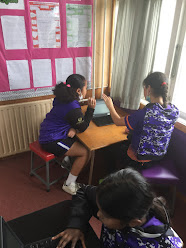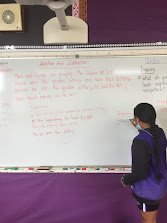Create an environment where learners can be confident in their identities, languages, cultures, and abilities.
Room 6 has students from diverse cultural backgrounds. Therefore, it is imperative that teaching and learning also focus on students' identities and cultures. A good example is the students of Room 6 celebrating a week-long Samoan Language week to show their respect and tolerance towards each other and learn alongside each other in harmony and in a peaceful environment.
Develop an environment where the diversity and uniqueness of all learners are accepted and valued.
 Below are the images of Room 6 students learning the English alphabet through the medium of sign language. This is in response to celebrating week-long sign language and also to accepting individual differences that are in all the learners.
Below are the images of Room 6 students learning the English alphabet through the medium of sign language. This is in response to celebrating week-long sign language and also to accepting individual differences that are in all the learners.Sign language is another form of communication that nearly all students can use and benefit from. It’s an exciting and engaging language that connects students with a range of different people. Learning signs is a multi-sensory experience, and the visual and tactile nature of signing helps to engage a variety of learners. Plus, it’s super fun!
There are a number of benefits to introducing sign language to your students. Signs can help students with speech and language delays communicate more effectively, and they can give everyone another means of communication. One more tool in the communication tool belt!
Most importantly it gives students an opportunity to embrace diversity by learning not only another language but also the rich history and culture of the deaf/hard of hearing community. Learning about someone else’s language and culture helps students make new connections, and creates a sense of belonging for those in your community who use sign language.
Remember, sign language is different across countries and languages. Each sign language has its own structure and grammar rules and incorporates hand signs, body language, facial expressions, and lip patterns. Be mindful about the resources you are using, and if you are unsure, talk to someone from the deaf/hard of hearing community in your local school district.
Teaching signs for a range of vocabulary words (e.g. nouns, verbs, adjectives) helps broaden students’ knowledge. Teaching students how to find words by using online sign dictionaries or other resources can help them to be lifelong learners while giving them more tools to use when they meet someone from the deaf/hard of hearing community.
Greetings are a good place to start introducing some signs because they happen every day and are often the first things we say to someone when we meet them. This includes the signs for hello and goodbye and asking for someone’s name. It might be helpful to have students think about cultural behaviors when meeting someone from the deaf/hard of hearing community.
Things like getting the person’s attention before signing, changing positions so it is easier to see signs, and taking turns in conversations so only one person is signing at a time
One of the best ways in which effective learning-focused relationships can be established is to provide opportunities to students to be active participants in the process of learning, sharing ownership and responsibility for learning.
Demonstrate high expectations for the learning outcomes of all learners, including for those learners with disabilities or learning support needs.
Here are some of the recipients of high achievements. Their successes are celebrated by honoring them with tangible rewards to reinforce high expectations and empowering them to perform to the standards and try their best. At the same time, this is also an opportunity to inspire other learners to perform better.
Develop learning-focused relationships with learners, enabling them to be active participants in the process of learning, sharing ownership and responsibility for learning.
One of the best ways in which effective learning-focused relationships can be established is to provide opportunities to students to be active participants in the process of learning, sharing ownership and responsibility for learning.
When students are taking ownership of their learning, they have a lot to share with their peers. they build their confidence to communicate freely and respectfully with others. This creates a kind of classroom environment where students find themselves safe to learn and need not worry about making mistakes in their learning.
It is very important that students must have a very significant voice in their learning so that they feel that they are the major players in the design of the learning.
Giving the responsibility to the students for their own learning gives a purpose to the students for coming to school every day. Students clearly are aware that they are the real deal in the classroom. Their aspirations and dreams take off in the classroom when they see themselves making steady progress in their learning,
Giving responsibility for their own learning show students how they are becoming better learners on a regular basis, particularly by embracing mistakes. I frequently share my own errors so that students realize it’s OK to mess up as long as we learn from it. I told my class about a major mistake I made while I was a student. Without the experiences of failure, we don’t get better.
If students can make mistakes desirable, they truly experience the value of a growth mindset that encourages a “not yet” approach to learning. Students are more likely to own their growth if they realize that success is a process that involves some struggle.
Responding to feedback and making changes based on their suggestions communicates to students that we value their ideas and perspectives. If students feel comfortable providing input that is informative but not tied to a grade or other consequence, we can better address learning needs. Authentic success is the one students achieve by being responsible for their own learning.






















I asked myself why I am taking images of my students while they are actively engaged with the tasks. The answer lies in the fact that these images are going to become wonderful memories in years to come. I can easily go back into time and recall many memorable times in my teaching career.
ReplyDelete